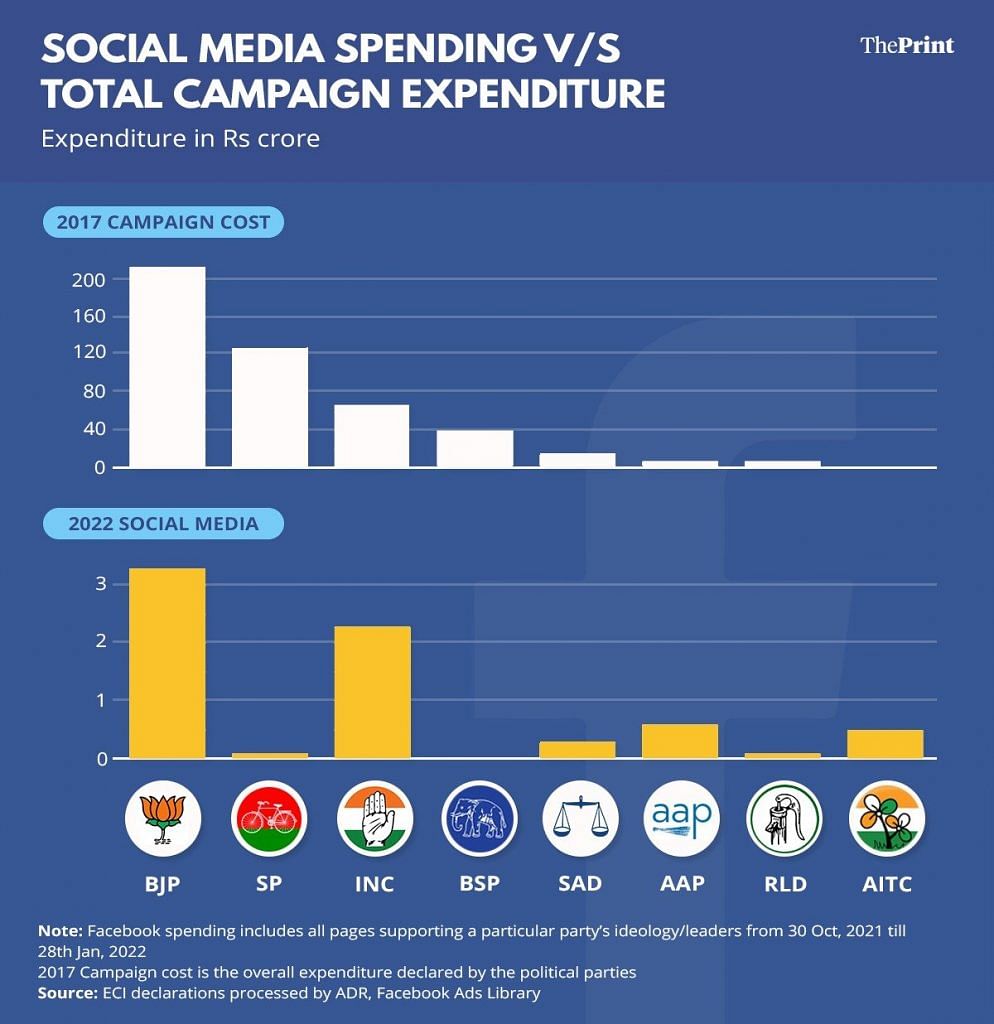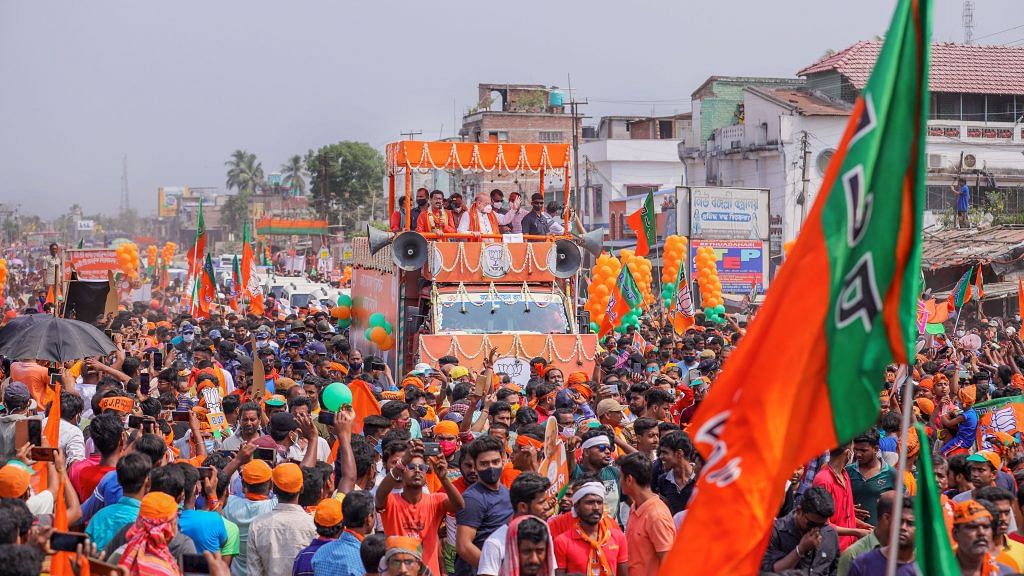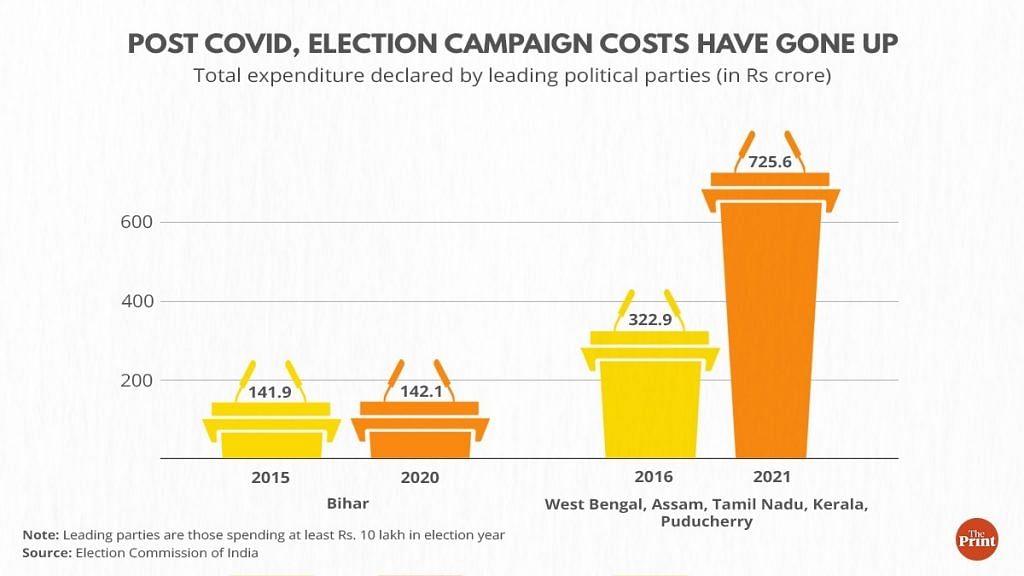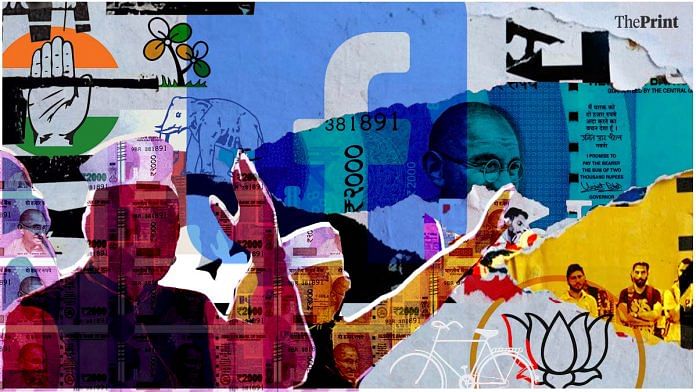New Delhi: Once the Election Commission of India (ECI) imposed restrictions on physical rallies and roadshows due to Covid-19, the obvious conclusion to draw would be that political parties must have splurged on a social media blitz to target voters in poll-bound Uttar Pradesh, Uttarakhand, Punjab, Goa, and Manipur. However, put this theory to test, and the results are surprising.
ThePrint’s calculations showed that over the last three months, political ad spends on Facebook came to only around Rs 8 crore for all the states that are holding assembly elections this February.
In poll campaign terms, this is peanuts. In the 2017 assembly elections in these states, for instance, the key national and regional parties taken together spent Rs 494.36 crore in total, of which Rs 300.23 was on publicity, according to an analysis of declared campaign spending by the election watchdog Association of Democratic Reforms. And it’s not as if election spending has plummeted due to Covid since then. In the 2021 elections in Assam, West Bengal, Tamil Nadu, and Puducherry, political parties, taken together, declared they spent twice the amount they did in 2016.

At the very least, these figures suggest that political parties are spending only a minuscule part of their campaign budgets on social media ads despite the fact that they cannot go on the ground to rally mass support.
Before delving into possible reasons for this, however, here’s a closer look at the political ad spends on Facebook, a platform ThePrint chose to study largely because, unlike other tech giants, it does not limit political advertising and also provides transparent data about every ad posted.
Also Read: From ‘I had idli’ to political megaphone, how tiny Twitter punches above its weight in India
Deep dive into parties’ Facebook ad spend in poll-bound states
First, a quick run-through our methodology. As a transparency measure, the Facebook ads library provides data of spending on political endorsements as well as ads about social issues. In the 90 days preceding 28 January, the poll-bound states saw political and social ads amounting to Rs 12.68 crore in total.
Going state by state, ads worth Rs 7.8 crore were received from UP, Rs 2.87 crore from Punjab, Rs 1.1 crore from Goa, Rs 78 lakh from Uttarakhand, and Rs 12.6 lakh from Manipur. However, these numbers also included ads on social issues by various organisations.
Since there are thousands of pages posting ads that cost varying amounts, we put a filter on the minimum spending to analyse these ads. For Uttar Pradesh, the state with the biggest electorate in the country, the minimum ad spending was set at Rs 50,000 per page. For Punjab, it was set at Rs 10,000 per page, for Goa and Uttarakhand at Rs 5,000 each, and Rs 2,000 for Manipur.
By filtering out pages with the minimum amount criteria, we captured 80-90 per cent of the value of total ads posted by 548 pages within the last three months. We then scanned each page manually to check which political party’s content it was supporting. All the pages posting non-political content were then removed.
After filtering out social ads and those that were below the minimum set values, the total spends on political ads amounted to Rs 8 crore.
Among the political endorsements, the data showed that the Bharatiya Janata Party (BJP) was the top spender overall with ads worth Rs 3.34 crore. The Congress was at second place at Rs 2.25 crore. Overall, pages supporting these two parties accounted for about 70 per cent of the total political ads.

However, going state by state, the top spenders vary.
The BJP is leading in ads only in Uttar Pradesh and Manipur. In UP alone, the party has spent close to Rs 3 crore, which is about 70 per cent of the total value of ads posted in the state. The Congress, in contrast, has spent about 92 lakh.
In Manipur, the BJP (and supporting pages) have spent about Rs 6.8 lakh, making up 90 per cent of the total political ads in the state.
In Punjab and Uttarakhand, however, the Congress leads in ad spending. In Punjab, where the party is currently in power, it spent Rs 1.1 crore in Facebook ads, while the BJP shelled out only Rs 11 lakh. In Uttarakhand, the Congress spent Rs 15 lakh, and the BJP 11 lakh.
In Goa, Mamata Banerjee’s Trinamool Congress and supporting pages spent close to Rs 50 lakh, which is almost half of the total value of political ads in the state over the period studied.
Notably, the Aam Aadmi Party (AAP) has contributed substantially to the political ad spend pie in states where the BJP has been less lavish (at least on Facebook). AAP bagged third position among top spenders in Punjab (Rs 30 lakh), Uttarakhand (Rs 10 lakh), and Goa (Rs 12.6 lakh).
Why aren’t political parties spending more on social media?
Political parties have been leveraging various digital platforms for a while, and have spent big bucks on Google ads and Facebook before the pandemic too. In theory, Facebook should be the most appealing among all the tech giants to political parties, since Twitter has completely blocked political advertising and Google has put limits on whom political advertisers can target.
With restrictions on physical campaigning, it would seem that parties would spend a significant portion of their campaign budget on Facebook ads. But, taking the overall publicity spends by national and regional parties in the 2017 elections — Rs 300.23 crore — as a benchmark, the money spent on Facebook ads this time is a mere fraction of this amount.
One possible explanation for the low spend is that there is no real need to splurge too much on Facebook ads, you just get more for less. According to the rates offered by Facebook Ads Manager, just Rs 10,000 can buy a reach of 70,000 to 2 lakh people a day. If we assume an ad reaches the average of 135,000 people, for every 1,000 people reached, one needs to spend only Rs 74 on average.
Compare this to a full front page advertisement in a Hindi newspaper, say Dainik Jagran, which has a daily circulation of over 3 lakh in Delhi. A front-page ad in this edition alone is likely to cost upwards of Rs 55 lakh. Even if every newspaper is read by a household of, say, three people, that amounts to a spend of around Rs 6,000 to reach 1,000 people — which means a Facebook ad is about 80 times cheaper than a newspaper ad.
“Compared to any legacy media, say print or TV, or other advertising platforms, the cost effectiveness is the highest in digital ad spending, if the goal is just to reach people and nothing beyond it,” Sagar Vishnoi, chief strategist at the Ideaz Factory, a Chandigarh-based political communications firm, said.
“Digital ads also offer the choice to reach a specific age bracket, income group, and gender — something which is difficult to find in traditional media platforms,” Vishnoi added.
Despite these advantages of digital ads, why are political parties still willing to pay high rates for traditional advertisements?
Amit Malviya, in-charge of the BJP’s information & technology department, told ThePrint that each platform has its benefits.
“Traditional media has limited space and audience concentration over a time and space, so it is auctioned at a higher price as compared to digital,” Malviya said, adding that the advantages of digital platforms are flexibility and “the option to reach the end consumer at their convenience”.
Vishnoi also acknowledged that digital ads were no substitute for other types of outreach ahead of elections. According to him, Facebook ads are an “add-on cost, just to show a digital presence” but that they don’t necessarily cut much ice with voters.
“How many times a leader visited a voter’s area, how many gatherings, and door-to-door campaigns they conducted matter a lot. Sometimes even a small felicitation can do a lot to build that trust, as far as India is concerned. Spending on physical campaigns is likely to influence a voter more than a Facebook ad,” Vishnoi said.
This may help explain why the availability of “budget” social media platforms and ad spaces have not made conducting elections any cheaper even during Covid restrictions.
Election costs have risen during Covid
One might think that digitisation and restrictive Covid policies set by the ECI might make elections lighter on the pocket, but so far this hasn’t been the case.
The campaign expenditure declared by leading parties (spending a minimum of Rs 10 lakh) in the 2021 assembly elections of Assam, West Bengal, Tamil Nadu, Kerala, and Puducherry was about Rs 726 crore. In the 2016 assembly polls, the same parties had spent only Rs 320 crore, which means their election expenditure had more than doubled in 2021. It is worth noting, however, that the October 2020 elections in Bihar did not show such a dramatic change and there was only a 0.15 per cent rise in total declared campaign expenditure by political parties. But this election was held just after the first wave restrictions were lifted, and things hadn’t really returned to “normalcy” yet.

Nevertheless, the rising poll costs post-Covid could indicate that parties have had to use their campaign funds in new and costlier ways, according to Gilles Verniers, assistant professor and co-director of Ashoka University’s Trivedi Centre for Political Data (TCPD).
“In order to have a well-digitised election, political parties have to invest in digital infrastructure. If you have to ask workers to come to a virtual rally, they need devices, internet connection, and all what’s needed to access these rallies. Hence, it could be a part of the reason why poll expenses are rising despite the pandemic,” Verniers told ThePrint.
He explained that localisation of campaigns could also be a contributing factor in rising poll costs.
“Political parties are moving to a more localised form of campaign, for which workers’ engagement with voters has increased. These workers need to be paid off, which could explain why these costs have risen,” he said.
In this scenario, parties that have been able to set up the infrastructure needed for virtual rallies and social media mobilisation stand to benefit, leaving smaller and newer parties at an even greater disadvantage.
“[Smaller parties] definitely stand to lose in front of the big players. The big parties have taken years to master their social media strategy. They have experience on social media, they have a dedicated team which the small and local contenders do not,” Sanjay Kumar, co-founder of Lokniti, a research initiative of the think-tank Centre for the Study of Developing Societies (CSDS), said.
According to him, the ECI restrictions should have been announced earlier — up to a year in advance — in order to set up “a level playing field”.
“It is not possible for small players to build up an infrastructure for digital campaigns so quickly,” Kumar added.
(Edited by Asavari Singh)
Also Read: UP voters prefer Facebook over Twitter for state politics updates: Digital marketing survey



